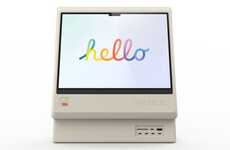
'History of Icons' Collects Icons and Logos from Computing History
Joey Haar — August 23, 2017 — Art & Design
References: historyoficons & producthunt
Digital interfaces are so ingrained in daily life that it's easy to forget the amount of thought behind their design; 'History of Icons' illustrates that growth in detail. The site is a collection of icon and interface designs from computers over the last 30-plus years. It's organized chronologically, allowing viewers to see just how designers' philosophies have changed since the inception of graphical computer interfaces in the eighties.
One of the biggest movements over the history of icon design mimics that of art history more generally. In art, painters over time strove to master as realistic an image as possible, with techniques being developed solely to capture real life accurately. Eventually, late 19th and early 20th century painters abandoned realism in favor of expression. So the same happened with icons, as designers worked to create realistic-looking graphics until computers could easily render those, at which point icons became far more expressive of function and brand image.
One of the biggest movements over the history of icon design mimics that of art history more generally. In art, painters over time strove to master as realistic an image as possible, with techniques being developed solely to capture real life accurately. Eventually, late 19th and early 20th century painters abandoned realism in favor of expression. So the same happened with icons, as designers worked to create realistic-looking graphics until computers could easily render those, at which point icons became far more expressive of function and brand image.
Trend Themes
1. Evolution of Digital Interfaces - The 'History of Icons' collection showcases the evolution of icon and interface designs, highlighting the timeline of changes in designers' philosophies.
2. Shift From Realism to Expression - The movement in icon design mirrors the shift in art history, where icons became more expressive of function and brand image rather than focusing on realistic graphics.
3. Influence of Technological Advancements - The collection demonstrates how advancements in technology have impacted the design of digital interfaces, allowing for more expressive and visually compelling icons.
Industry Implications
1. Graphic Design - The graphic design industry can leverage the 'History of Icons' collection to gain insights into the evolution of digital interface design and incorporate new trends into their work.
2. User Interface Design - The user interface design industry can benefit from studying the collection to understand the historical context and evolution of icons, informing their design decisions for modern interfaces.
3. Branding and Marketing - Branding and marketing professionals can refer to the collection to explore how icons have become powerful visual representations of brands over time and utilize this knowledge to enhance brand identity and recognition.
3
Score
Popularity
Activity
Freshness






















